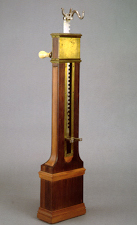
97 x 22.5 x 10.5
Wood, iron, brass and ivory
INDEX 1788 : E.V.147
Pancration cum regula dentata, ferrea, cujus capiti, vel imae parti onera tolenda, vel movenda imponuntur. Vulgo dicitur Maccaco.
"Pancration" with toothed iron bar, on the upper or lower part of which are placed the loads to be raised or moved. Commonly called a jack.
This mechanism, called pancration by dalla Bella, is shown in an engraving from Musschenbroek. It consists of a toothed iron rack, which engages with a pinion with the same axle as a cogwheel; this, in turn, engages with another pinion moved by a handle. The force exerted on this handle will raise an object resting either on the top of the rack, or on a platform beneath it.
The multiplication factors of the force will be the ratio between the length of the handle and the radius of the pinion which engages with the rack, and the ratio between the radii of the cogwheel and of the pinion which engages with it.
The jack in the Physics Museum is covered by a wooden casing; it appears to be incomplete as it lacks the cogwheel and the pinions shown by Musschenbroek's model.
From Colégio dos Nobres, catalogue n.º 138.
Carvalho, Rómulo de, História do Gabinete de Física da Universidade de Coimbra, Universidade de Coimbra, Biblioteca Geral, Coimbra, 1978, pp. 290-291.
Musschenbroek, Peter van, Introductio ad Philosophiam Naturalem, Leiden, 1762, § 497, Tab. IX, Fig. 6.
Desaguliers, Jean-Théophile, A Course of Experimental Philosophy, London, Vol. I, Pl. 12, Figs. 5 and 6.